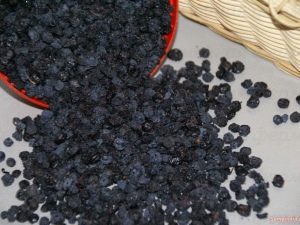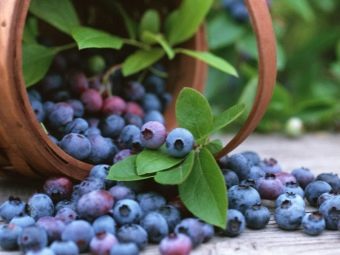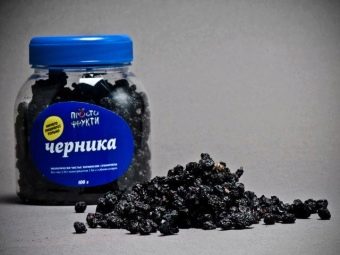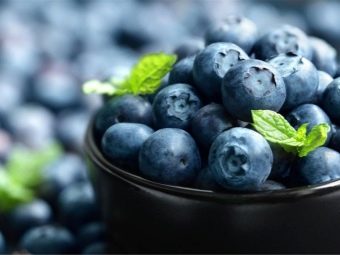Dried blueberries: useful properties and application

Blueberry is a small vitamin pantry, known to everyone as a berry, restoring vision.But in addition to the positive impact on the structure of the eye, it has many useful substances that improve many of the processes in our body. Since ancient times, our ancestors harvested blueberries for the winter in order to enrich themselves with vitamins and treat some diseases during this period. That is why the best method was to dry the berries.
Special features
Bilberry is a short, perennial shrub whose berries ripen in August. They are black with blue bloom, dark red flesh and lots of seeds. Berry picking starts from the moment of ripening, but the leaves - in May or June.
This shrub can only grow in natural conditions. The area in which the blueberry bush grows, has a special soil, humidity and temperature. In such favorable conditions for this shrub berries and leaves are filled with a mass of nutrients.
Blueberry fruits
Low-calorie blueberries - 60 kcal per 100 grams of berries.
Nutritional value: proteins - 1.3 g, fats - 0.9 g, carbohydrates 7.8 g, ash - 0.5 g, water - 88 g. The berry contains:
- tannins - 18%;
- organic acids - 8% (succinic, malic, oxalic, quinic, lactic, citric);
- sugar - 29%;
- ascorbic acid - 7 mg /%;
- carotene -0.73-1.8 mg /%;
- group of vitamins B - 0.06%.
Berry seeds contain 15% protein and 32% fatty oils.
Blueberry leaves
Blueberry leaves contain:
- tannins - 21%;
- sugar - 17%;
- Arbutin - 0.57%;
- hydroquinone - 0.049%;
- saponins - 2.3%;
- organic acids - tartaric, gallic, citric, malic, acetic, benzoic, oxalic.
- mineral substances - chlorine, magnesium, potassium, sulfur, sodium, iron;
- glycosides - neomirtilin 2%.
Useful properties of dried bilberry
Based on such a large composition of useful substances, You can identify what positive properties this plant has:
- hypoglycemic effect is due to organic acids;
- excellent remedy for diarrhea, since the fruits contain a large amount of tannins;
- improves eyesight and reduces eye redness due to carotene;
- increases the secretion of hydrochloric acid due to irritation of the mucous membrane of the gastrointestinal tract with organic acids;
- improves digestion;
- prevention of cancer is due to the antioxidant effect;
- anti-rotten effect;
- antimicrobial action;
- regenerative effect;
- healing action.
Contraindications
Bilberry is such a unique plant that it has an extremely small number of contraindications:
- individual intolerance;
- chronic constipation, as the berries contain a large amount of tannins;
- pancreatic diseases. Such a rich composition of berries enhances the secretory function of the pancreas, and this is bad for pathological processes.
How to dry blueberries?
In order to dry blueberries for the winter, you will need:
- blueberries;
- pan;
- baking paper.
The procedure is as follows:
- Preparation of berries. The first step is to sort out the blueberry fruit from the garbage and wash. To do this, you need a bright surface, for example, a table with a white oilcloth, on which damaged berries and unnecessary garbage will be clearly visible. To wash the berries from plaque, it is best to use warm water and a colander, in which then we leave the berries for the full runoff of water.
- Oven preparation. After the berries have dried in a colander, you can turn on the oven. You will need a temperature of 60-65 degrees.
- Bilberry Drying. Blueberries are laid on a baking sheet, which must be laid in advance with baking paper so that the berries are in one layer. This is very important, since the fruits should not be in contact with each other, so that they do not stick together later on when drying. Put the pan in the oven and leave for an hour. At the same time it is important to slightly open the cabinet door.After an hour has passed, we cool the fruits of blueberries, and do the same for 5 days in a row.
There is a slightly different method. For him you will need:
- blueberries;
- pan;
- gauze;
- cotton fabric.
This method does not require an oven, instead you need a dark, dry place.
The action box for this method is:
- Preparation of berries. Perform with accuracy as described above.
- Drying berries. Put a cotton cloth on the baking sheet, onto which we pour the already cleaned blueberries. This is necessary so that the canvas absorbs the liquid that will evaporate in the process of drying the berries. Then we cover the blueberries with insect gauze.
This method does not require effort, but it takes time to complete. It is best to apply it in the warm season, immediately after collection.
You can not dry berries in the sun, as ultraviolet destroys many of the components that make up blueberries. The best solution would be a hot room, with good ventilation, for example, in a private house it may be a veranda.
To date, in the appliance stores sell special dryers for fruits and berries. If you purchased such a useful device, you can safely use it. Since modern developments provide for the maximum preservation of the useful composition of a particular berry.
How to dry blueberries, see the following video.
Rules of application
Dried blueberries can be used as a treat, medicine and prophylactically according to indications.
- In the winter season, with frequent colds, tea from dry fruits will help you. To do this, you need to pour 2 spoons of blueberries into a cup and pour 200 ml of hot water. Let it brew for 5-7 minutes. Vitamin tea is ready to drink.
- Kissel from blueberries will not only enrich your body with vitamins, but will also be an excellent treat for your child. To do this, boil 20 grams of blueberries in one liter of water and mash the berries. Then add 40 grams of starch, 20 grams of sugar and continue to cook over low heat until ready.
- Infusion of blueberries is prepared from 10 grams of berries, which pour 200 ml of hot water. Then give to brew for at least 2 hours. Such a drink can be drunk either warm or cold. This infusion should be drunk with a cold about 4 times a day in a warm form.
- Dried blueberry compote. To do this, you need 2 cups of fruit, 3 liters of water, 4 tablespoons of sugar (who loves sweeter, you can 5 spoons). All ingredients need to be mixed and cooked over low heat. This drink should boil for 15 minutes.
- Vitamin cocktail. Since blueberries have antioxidants properties, they can be used in combination with milk and banana. To do this, pour a tablespoon of berries with warm milk, and then add sliced bananas. After that, it is necessary to grind all this in a blender to a homogeneous consistency. Such a nutritious vitamin cocktail heals the body with its unique composition.
- Your cake will become much more fragrant and tastier if you add dried blueberries to the dough.
- Enrich yogurt vitamins can be very simple. To do this, fill the blueberries with boiling water so that they become softer. Then drain the water and add the yoghurt to the cup and mix.
- Dried berries can be ground into powder, then the capacity for storing the useful powder will be needed much smaller. It can be added to any culinary product for taste and benefit.
Tips and tricks
To use blueberries only Use the advice of experts.
- Do not forget that even the dried berries need to sort out. Since during storage, the dried fruits of blueberries can deteriorate. To use the spoiled product is strictly prohibited due to the fact that toxins are released, which adversely affect human health.
- Dried blueberries should not be used for therapeutic and prophylactic purposes without consulting a doctor.In connection with the individual characteristics of each organism, past diseases, there may be contraindications to the use of blueberries.
- It is important to remember that dried berries have their shelf life. And if this period has passed, and the fruits have the same appearance, it is best to dispose of them in order not to harm the body.
- Before you give your child a decoction or any other blueberry product, you should first consult with your pediatrician.
If blueberries are your favorite berries, it does not mean that it can be used in large quantities. After all, this fruit gives allergic reactions in the form of urticaria and angioedema.






































